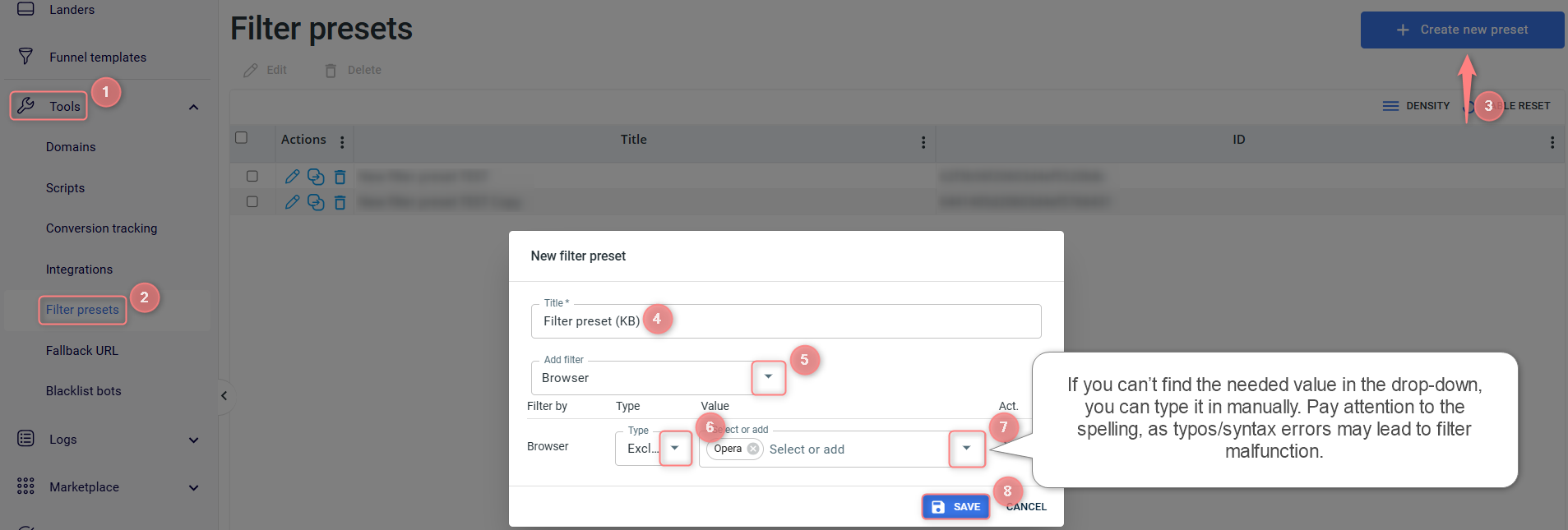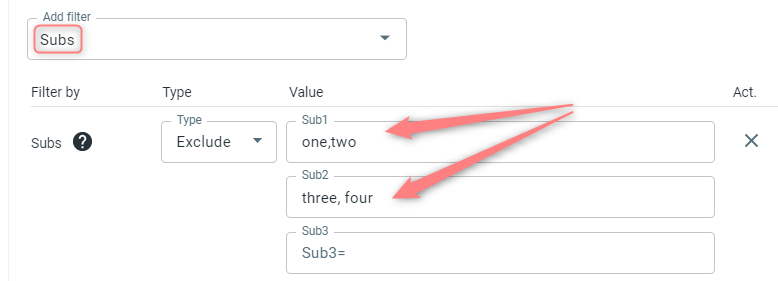Traffic filtering
Overview
Traffic filtering means redirecting your traffic based on the set criteria (geo, ISP, OS, etc.). This feature is useful for those working with more complex funnels where you may have different landing pages for different locations or different offers for mobile and desktop visitors. In RedTrack we have one of the best end-expensive proxy bases which distinguishes us from other similar services.
Having the possibility to sort out the traffic by these criteria is very important for our clients as some offers for example may not be paid by the reason of so-called proxy-users as in many cases it is related to fraud. In order not to lose reputation, it is sometimes better to filter the traffic this way.
Supported filters can be viewed and applied in Campaigns → edit → Funnels → Filters → Add filter.
RedTrack can currently offer the following filter categories:
- Countries
- Regions
- Cities
- ISP
- Browser
- Browser version
- OS
- OS version
- Device brand
- Device model
- IP
- Sub-values
- Languages
- Referrer
- Referrer domain
- Device type
- Connection types
- Proxy types
- Fraud check
- Unique path (contact sales@redtrack.io to activate this filter)
With no-redirect tracking, filtering works on the offer level only (considering you have a landing page + the offer in the funnel)
How filters work
RedTrack allows you to create custom filters that can be added either as pre-set templates or directly on the Campaign level. To set it up act depending on the chosen method:
Go to Funnels → choose the needed one (if you have multiple funnels) → Filters → choose the filter from the Add filter drop-down → choose the Type and the Value for it (type and value define how the filter works out) → Save changes:

Filter by
Most of the filters are self-explanatory. That being said, some of them are specific in a way:
Filter’s name | Filter specifics |
Proxy type | This filter has the following types:
|
Subs | The sub-value you want to put inside the filter should be the same as you received from your traffic source with the click. If several values under the same sub are to be used, put them in the same field separated by a comma:  Important! If you want to filter a click with an empty sub value, you should put {null} instead the sub value when applying the filter by Sub:  |
Unique path | This filter ensures that returning users are redirected through specific paths within a campaign, based on their visit history. This is particularly useful in cases where multiple offers are available in a campaign funnel (e.g., to avoid showing the same offer multiple times, or to ensure consistency). The “Unique path” filter can work in two modes: – Using it with the “Exclude” type ensures that users are shown a different path (offer) each time they visit. – Using it with the “Include” type ensures that users are consistently shown the same path (offer) they saw on their first visit. How it works: Using this filter with “Exclude” type: 1. User clicks an ad → lands on Offer 1. 2. On the next visit, the same user is redirected to a different offer (e.g., Offer 2). 3. On the third visit → Offer 3. 4. After all paths are used, the stats are reset and the cycle starts again. Using this filter with “Include” type: 1. User clicks an ad → lands on Offer 1. 2. On subsequent visits, the user is always redirected to Offer 1, as long as they’re identified as the same user. 3. Once the tracking window expires or data is reset, they may be sent to a new offer. How users are identified: RT tracks users based on a combination of their IP address + User Agent (UA) (which includes device and browser details).
Retention window: User path history is stored for 7 days. After all paths are visited, or the 7-day window expires, the stats are reset, and path assignment starts from the beginning. |
Type
Include vs Exclude
- Include type means that the page will be available for a certain group of people only.
All the conditions should be met for the click to be sent to this funnel.
Your filters are:
Filter by countries → Include → Germany
Filter by OS → Include → Windows
Result:
Your funnel will be shown only for people from Germany with Windows OS, non-matching clicks from Germany and MacOS will be redirected to another funnel or the default fallback URL (make sure you set it up).
- Exclude type means that your offer will be shown for everyone except those values in the filters.
Only one of the conditions can be met for the filter to be triggered.
No matter if it is the “Include” or “Exclude” condition.
Example
Considering the click is coming from the US in all the cases below
Include: US
Exclude: sub1 – 123
https://domain.com/67dbdac1f9cbc639f88?sub1=123 – blocked/fallback
https://domain.com/67dbdac1f9cbc639f88?sub1=245 – accepted
Exclude: US
Exclude: sub1 – 123
https://domain.com/67dbdac1f9cbc639f88?sub1=245 – blocked/fallback
https://domain.com/67dbdac1f9cbc639f88?sub1=123 – blocked/fallback
Include: US
Include: sub1 – 123
https://domain.com/67dbdac1f9cbc639f88?sub1=123 – accepted
https://domain.com/67dbdac1f9cbc639f88?sub1=245 – blocked/fallback
Contains vs No contains
Contains and No contains filter types work the same way as Include/Exclude but for partial matching.
If your filter is Subs → Set contains 12345, but the Subs data will have 123456 upon the click, the system will count this click with 123456 as matching the filter.
1. Go to Tools → Filter presets → Create new preset → give it a name → choose the filter → add Type and Value (type and value define how the filter works out) → Save:

Filter by
Most of the filters are self-explanatory. That being said, some of them are specific in a way:
Filter’s name | Filter specifics |
Proxy type | This filter has the following types:
|
Subs | The sub-value you want to put inside the filter should be the same as you have received from your source of traffic with the click. If several values under the same sub are to be used, simply put them in the same field separated by a comma:  Important! If you want to filter a sub with an empty value, you must put {null} in the sub value when applying the filter by Sub:  |
Unique path | This filter ensures that returning users are redirected through specific paths within a campaign, based on their visit history. This is particularly useful in cases where multiple offers are available in a campaign funnel (e.g., to avoid showing the same offer multiple times, or to ensure consistency). The “Unique path” filter can work in two modes: – Using it with the “Exclude” type ensures that users are shown a different path (offer) each time they visit. – Using it with the “Include” type ensures that users are consistently shown the same path (offer) they saw on their first visit. How it works: Using this filter with “Exclude” type: 1. User clicks an ad → lands on Offer 1. 2. On the next visit, the same user is redirected to a different offer (e.g., Offer 2). 3. On the third visit → Offer 3. 4. After all paths are used, the stats are reset and the cycle starts again. Using this filter with “Include” type: 1. User clicks an ad → lands on Offer 1. 2. On subsequent visits, the user is always redirected to Offer 1, as long as they’re identified as the same user. 3. Once the tracking window expires or data is reset, they may be sent to a new offer. How users are identified: RT tracks users based on a combination of their IP address + User Agent (UA) (which includes device and browser details).
Retention window: User path history is stored for 7 days. After all paths are visited, or the 7-day window expires, the stats are reset, and path assignment starts from the beginning. |
Type
Include vs Exclude
- Include type means that the page will be available for a certain group of people only.
All the conditions should be met for the click to be sent to this funnel.
Your filters are:
Filter by countries → Include → Germany
Filter by OS → Include → Windows
Result:
Your funnel will be shown only for people from Germany with Windows OS, non-matching clicks from Germany and MacOS will be redirected to another funnel or the default fallback URL (make sure you set it up).
- Exclude type means that your offer will be shown for everyone except those values in the filters.
Only one of the conditions can be met for the filter to be triggered.
No matter if it is the “Include” or “Exclude” condition.
Example
Considering the click is coming from the US in all the cases below
Include: US
Exclude: sub1 – 123
https://domain.com/67dbdac1f9cbc639f88?sub1=123 – blocked/fallback
https://domain.com/67dbdac1f9cbc639f88?sub1=245 – accepted
Exclude: US
Exclude: sub1 – 123
https://domain.com/67dbdac1f9cbc639f88?sub1=245 – blocked/fallback
https://domain.com/67dbdac1f9cbc639f88?sub1=123 – blocked/fallback
Include: US
Include: sub1 – 123
https://domain.com/67dbdac1f9cbc639f88?sub1=123 – accepted
https://domain.com/67dbdac1f9cbc639f88?sub1=245 – blocked/fallback
Contains vs No contains
Contains and No contains filter types work the same way as Include/Exclude but for partial matching.
If your filter is Subs → Set contains 12345, but the Subs data will have 123456 upon the click, the system will count this click with 123456 as matching the filter.
2. To apply this filter template, go to your campaign settings → Funnels → choose the needed one (if you have multiple funnels) → Filters → choose the added filter preset from the Select a preset field → Save changes to the campaign:



